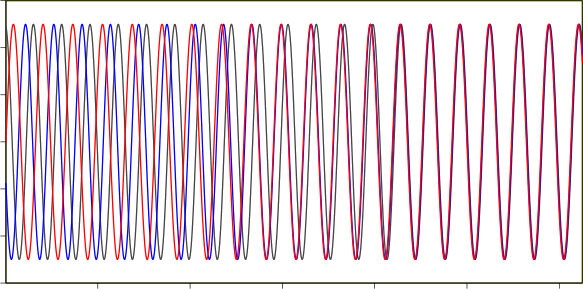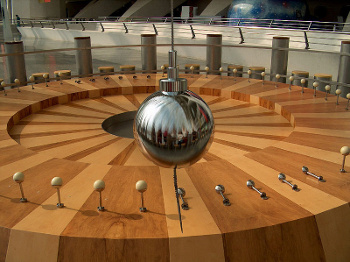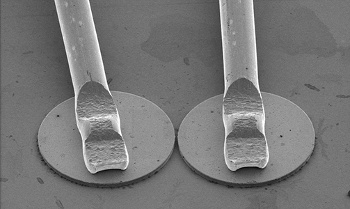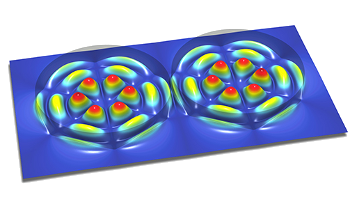Coupled Lasers
July 18, 2014
When doing
experiments,
scientists strive to isolate the object under study. It's no use trying to measure small
magnetic fields when you haven't taken the precaution of using
Helmholtz coils to null the
Earth's magnetic field. If you're a
chemist looking for trace
concentrations of
ions, you had better use
deionized water for your
analysis, and not
tap water.
My first introduction to how one
physical system can interfere with another was in my
elementary school days when I was experimenting with
radio circuits. If two
inductor-
capacitor (LC)
oscillators operating at nearly the same
frequency are placed close to each other, the magnetic field of each inductor will influence the other. This magnetic coupling causes the frequencies of the oscillators to "lock" onto the same oscillation frequency.

Synchronization of three coupled oscillators. The data are from a computer simulation by the author, rendered using Gnumeric)
This effect, called
injection locking is put to good use in
laser engineering when
high powered lasers are injection-locked to more precise, lower power lasers. In this case, the so-called "master" laser's low
noise signal is injected into the
optical resonator of the larger, "slave," laser through a partially-
transparent mirror. As with the LC oscillator example, above, the laser
wavelengths need to be close, but higher power in the master oscillator allows injection-locking when there's a considerable wavelength difference between the master and slave lasers.
As I wrote in a
previous article (Coupled Oscillators, November 15, 2011), the first
observation of coupled oscillators was by
Christiaan Huygens, who observed this effect for
pendulums, which are
mechanical oscillators. Huygens, who was the inventor of the
pendulum clock, quite
accidentally noticed that two pendulum clocks, mounted on the same structure, would eventually synchronize in a state in which their pendulums would swing in exactly opposite directions.[1]
Huygens called the effect, odd sympathy, since the pendulums synchronized 180°
out of phase. There are a few online examples of coupled pendulums.[2-3] It's easy to think that this synchronization is caused by a
momentum transfer of one pendulum to the other through the shared mounting, but the actual reason is somewhat more elusive.
Scientists from the
Georgia Tech did a further study of Huygens' pendulums in 2002, and they found that the synchrony is caused by the
friction at the pendulum pivot. When the pendulums are swinging with the same
amplitude in opposite directions, the pivot friction is minimized, and the system prefers that lowest
energy state.[4] Coupling of oscillators can improve their frequency
precision.[5]

A type of pendulum with some physics of its own.
A Foucault pendulum at the City of Arts and Sciences, Valencia, Spain.
(Photo by Daniel Sancho, via Wikimedia Commons.)
Recent research by scientists from the
Vienna University of Technology (Vienna, Austria) and
Princeton University (Princeton, New Jersey) has shown that coupled lasers can show the
paradoxical behavior that additional
energy can switch them off, while a reduction of energy can switch them on. Under the same excitation, the lasers would each emit
light when isolated, but they switch each other off when coupled. This
switching effect opens the possibility for a different type of optical
logic circuit.[6-8]
The idea for such a device came from a
theoretical observation by
Hakan Türeci, an
assistant professor of
electrical engineering at Princeton University, who developed a
mathematical model of the complex interactions that exist in
semiconductor lasers of
micrometer and
nanometer dimension.[9] The model incorporates
non-Hermitian matrices that allow for
asymmetries in a system's function. These asymmetries arise from
quantum effects appearing at such small scales.[7]
In closely coupled miniature lasers, these quantum effects allow for a
spatial manipulation of the optical
gain of the laser
medium; that is, an area of optical
amplification can be adjacent to an area of optical
loss. A
collaboration was formed between Princeton and the Vienna University of Technology in an attempt to make such small lasers more
efficient.[7] In 2012,
computer simulations by this
research team showed the possibility of a laser system that will shuts off when supplied with additional energy.[10]
Such a
phenomenon happens at so-called exceptional points, which are points in the
parameter space of these lasers where a resonant mode with gain coincides with another with loss in both position and their
width.[6] Says
Stefan Rotter, a
professor at the Vienna University of Technology,
"We were puzzled when we first discovered the effect in computer simulations... Usually, there is a simple relationship between the amount of energy which is pumped into a laser and the brightness of the beam emitted by it... Once a critical threshold is reached, the laser starts to emit light, and the more energy is put in, the brighter the laser beam gets."[8]
To prove the theory, they built small, coupled,
quantum cascade lasers, which emit at
terahertz frequencies. This is a rather long wavelength for an optical system, and that allows the coupling to occur.[8] As shown in the
electron micrograph, the two lasers are nearly touching, being separated by a distance just 2% of the
diameter of the lasers themselves.

Electron micrograph of two microdisk quantum cascade lasers, coupled by their micrometer proximity.
(Vienna University of Technology image.)
In operation,
electrical current is supplied to one laser, which starts to emit light. When electrical current is supplied to the other, that laser doesn't turn on; instead, this action causes the other laser to turn off.[7] For this effect to occur, an
absorbing layer must be placed on the lasers to dissipate part of the light.[8] Says Princeton's Hakan Türeci, "Loss is something you normally are trying to avoid... In this case, we take advantage of it and it gives us a different dimension we can use – a new tool – in controlling optical systems."[7]

Gain map of coupled lasers.
(Vienna University of Technology image.)
Such research could be important in the design of "
lab-on-a-chip" devices, which use the optical signatures of
tagged molecules for analysis. This phenomenon might allow such sensors to detect
chemical species at very low
concentrations.[7] It can be used, also, for
electro-optical switches, and for
optical computing devices.[8] Says Türeci, "Our approach provides a whole new set of
levers to create unforeseen and useful behaviors."[7]
This research was funded by the
Vienna Science and Technology Fund, the
Austrian Science Fund, the
Defense Advanced Research Projects Agency (DARPA); and the
National Science Foundation (NSF) through its support of the
Mid-Infrared Technologies for Health and the Environment Center (MIRTHE) at Princeton.[7]
References:
- Erica Klarreich, "Discovery of Coupled Oscillation Put 17th-Century Scientist Ahead of his Time," SIAM News, vol. 35, no. 8, October, 2002.
- Synchronisation of 5 coupled metronomes done in Lancaster University, Physics Department, YouTube Video by abahraminasab, December 18, 2007.
- Two pendulums attached to the same horizontal string transfer their motion back and forth, YouTube Video by Fred Wittel, September 7, 2007.
- Matthew Bennett, Michael F. Schatz, Heidi Rockwood and Kurt Wiesenfeld, "Huygens's clocks," Proc. R. Soc. Lond. A, vol. 458, (March 8, 2002), pp. 563-579.
- M. C. Cross, "Improving the Frequency Precision of Oscillators by Synchronization," arXiv Preprint Server, September 21, 2011.
- M. Brandstetter, M. Liertzer, C. Deutsch, P. Klang, J. Schöberl, H. E. Türeci, G. Strasser, K. Unterrainer, and S. Rotter, "Reversing the pump dependence of a laser at an exceptional point," Nature Communications, vol. 5 (June 13, 2014), Document No. 4034, doi:10.1038/ncomms5034. This is an open access publication with a PDF file available, here.
- Steven Schultz, "Strange physics turns off laser," Princeton University Press Release, June 17, 2014.
- Florian Aigner, "Laser Physics upside down," Technical University of Vienna Press Release No. 63/2014, June 17, 2014.
- Hakan E. Türeci, Li Ge, Stefan Rotter, and A. Douglas Stone, "Strong Interactions in Multimode Random Lasers," Science, vol. 320 no. 5876 (May 2, 2008) pp. 643-646, DOI: 10.1126/science.1155311.
- M. Liertzer, Li Ge, A. Cerjan, A. D. Stone, H. E. Türeci, and S. Rotter, "Pump-Induced Exceptional Points in Lasers," Phys. Rev. Lett., vol. 108, no. 17 (April 24, 2012), Document No. 173901.
Permanent Link to this article
Linked Keywords: Experiment; scientist; magnetic field; Helmholtz coil; Earth's magnetic field; chemist; concentration; ion; deionized water; analytical chemistry; analysis; tap water; physics; physical; system; elementary school; radio; electronic circuit; inductor; capacitor; oscillator; frequency; synchronization; computer simulation; Gnumeric; injection locking; laser; engineering; power; noise; signal; optics; optical; resonator; transparent; mirror; wavelength; observation; Christiaan Huygens; pendulum; harmonic oscillator; mechanical oscillator; pendulum clock; serendipity; phase; momentum; Georgia Institute of Technology; Georgia Tech; friction; amplitude; energy; precision; Foucault pendulum; City of Arts and Sciences; Valencia, Spain; Daniel Sancho; Wikimedia Commons; Vienna University of Technology (Vienna, Austria); Princeton University (Princeton, New Jersey); paradox; energy; light; switch; logic; theory; theoretical; Hakan Türeci; assistant professor; electrical engineering; mathematical model; semiconductor laser; micrometer; nanometer; non-Hermitian matrix; asymmetry; quantum effect; three-dimensional space; spatial; gain; material; medium; amplification; attenuation; loss; collaboration; efficient; computer simulation; research; phenomenon; parameter space; spectral linewidth; Stefan Rotter; professor; quantum cascade laser; terahertz; electron microscope; electron micrograph; diameter; electrical current; absorption; false color map; lab-on-a-chip; fluorescent tag; molecule; chemical compound; chemical species; concentration; electro-optics; electro-optical; optical computing; lever; Vienna Science and Technology Fund; Austrian Science Fund; Defense Advanced Research Projects Agency; National Science Foundation; Mid-Infrared Technologies for Health and the Environment Center.